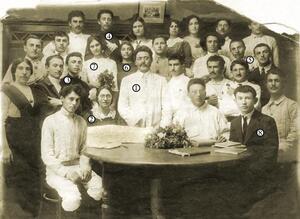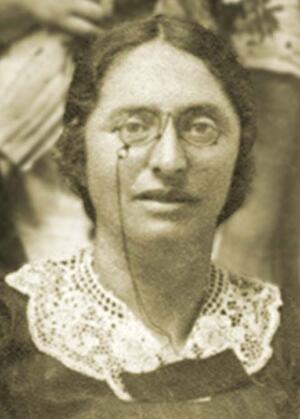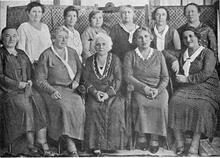Fania Metman-Cohen
Fania Metman-Cohen was born in Bialystok in 1974. She met her husband while attending the University of Odessa and they both became active in the Zionist circle surrounding Ahad ha-Am. Metman-Cohen set up the first Hebrew kindergarten in Odessa in 1899 and also ran a Zionist school there. In 1904 she and her husband immigrated to Palestine and opened a Hebrew school in Rishon Le-Zion. The following year they moved to Jaffa and helped establish Palestine’s first Hebrew high school, the Herzilya Gymnasia. Metman-Cohen actively involved herself in local cultural life, and the Gymnasia became a center for cultural revolution and revival. She was also a key figure in the Union of Hebrew Women for Equal Rights in Erez Israel and the Legal Defense Office for Women in Domestic Disputes.
The Zionist Movement in Odessa
Fania Metman-Cohen, née Brumer, was born in Bialystok. Her father, a well-educated attorney, was a Lit. "love of Zion." Movement whose aim was national renaissance of Jews and their return to Erez Israel. Began in Russia in 1882 in response to the pogroms of the previous year. Led to the formation of Bilu, the first modern aliyah movement.Hibbat Zion
adherent and traditional Jew. Fania attended the University of Odessa, where she met her husband Yehuda Leib Metman-Cohen (1869–1939) and became associated with Ahad ha-Am’s circles. These were years of crisis for Hibbat Zion: Anticipation of mass immigration that would change the destiny of the Land of Israel and the Jews was soon followed by disillusionment.
In 1891, as Russia suffered a harsh famine, Jews were expelled from Moscow but allowed to set up a committee to support Jewish emigration to Palestine. Lit. (Greek) "dispersion." The Jewish community, and its areas of residence, outside Erez Israel.Diaspora pressure, coupled with the enchanting dream of Jewish autonomy, was expected to give rise to a vast national movement. Yet it was these very expectations that paved the way for speculators and specious advertising. Land prices soared, the Ottoman authorities restricted immigration and intense and painful differences of opinion surfaced among Zionists. Ahad ha-Am and his associates reached a major turning point and decided to establish an educational movement that would strive for the establishment of an intellectual center in Palestine.
Fania Metman-Cohen set up the first Hebrew kindergarten in Odessa in 1899 and ran a Zionist school in 1902–1903, at which Chaim Nachman Bialik taught. She was active in the local B’not Zion organization for the education of Zionist women and—together with her husband—set up the Army of Rebirth Association that sent educators, physicians and other professionals to Palestine.
Establishing the Herzliya Gymnasia
In 1904 the Metman-Cohens were invited to Palestine to open a Hebrew school in Rishon Le-Zion. They offered a far-reaching proposal based on innovative educational principles, including the teaching of various subjects in Hebrew. Yehuda had studied philosophy, education, science teaching and Semitic philology in Switzerland and considered himself and his wife amply qualified to institute such reform. They organized the first torchlight parade in honor of Lit. "dedication." The 8-day "Festival of Lights" celebrated beginning on the 25th day of the Hebrew month of Kislev to commemorate the victory of the Jews over the Seleucid army in 164 B.C.E., the re-purification of the Temple and the miraculous eight days the Temple candelabrum remained lit from one cruse of undefiled oil which would have been enough to keep it burning for only one day.Hanukkah
, inaugurated science studies, conducted evening Hebrew classes and set up a choir. On the election of a new Village Council, however, some staunch opposition to their activities became evident. The Metman-Cohens’ rejection of the Uganda Plan and their connections with the Teachers’ Union only exacerbated their situation.

Courtesy of Tamar Eshel.
In 1905 the young couple moved to Jaffa, joining educator Shalom Mosenson in establishing the country’s the first Hebrew high school, the Herzliya Gymnasia—a difficult mission indeed. The Metman-Cohens lived in poverty and initially only a few students registered. In time, however, the Gymnasia began to flourish.
When the revolution broke out in Turkey, the Metman-Cohens sided with the Ottomans, as did the Gymnasia. Fania not only taught at the Gymnasia and washed its floors but also found time for active participation in local cultural life. She joined the Association of Hebrew Theater Arts and performed on stage, to the dismay of Jaffa’s traditional residents. The Gymnasia became a focus for cultural revolution and revival. Fania Metman-Cohen was also the author of a Hebrew arithmetic textbook.
During World War I most of the Gymnasia’s staff were dismissed and deported and the school itself was forced out of Jaffa. The Metman-Cohens remained with their students, continuing to teach when the Gymnasia moved to Shfeya.
Other Activities

Courtesy of Ha-Keren le-Ezrat ha-Isha.
Fania and Yehuda Leib Metman-Cohen always perceived themselves as loyal to the concepts of the Russian revolution of 1905 and socialism but were not always satisfied with their practical implementation. Yehuda represented the shoemaking profession and later became head of the Tel Aviv Workers’ Council, while Fania was a key figure in the Union of Hebrew Women for Equal Rights in The Land of IsraelErez Israel, the Legal Defense Office for Women in Domestic Disputes and was active in the Jewish National Fund. She was active in promoting local products and belonged to the [Hebrew] Language Defenders’ Brigade.
Interview to the Israel Broadcasting Authority (channel 1), 1975:
https://www.youtube.com/watch?v=L2WHe9_GNcY (min 20-24)
Shilo, Margalit. Girls of Liberty: The Struggle for Suffrage in Mandatory Palestine (Brandeis Series on Gender, Culture, Religion & Law). Waltham, MA: Brandeis University Press, 2016.
Tidhar, David, "Fania Matmon-Cohen." In Encyclopedia of Pioneers and Builders of the Yishuv, Vol. 2, 1947, p. 689.
(Accessed at: http://www.tidhar.tourolib.org/tidhar/view/2/689)




